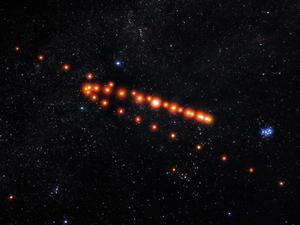Glossarbegriffe: Opposition
Description: Wenn sich zwei astronomische Objekte am Himmel in (genau) entgegengesetzten Richtungen zu einem Beobachter befinden, spricht man von einer Opposition. Dabei müssen nicht beide Objekte für den Beobachter tatsächlich sichtbar sein. Wenn der Mond in Opposition zur Sonne steht, haben wir Vollmond: Dann sind Sonne, Beobachter auf der Erde und Mond in einer Linie, sodass der sichtbare Teil der Mondoberfläche vollständig von der Sonne beleuchtet wird. Wenn die Ausrichtung perfekt ist, sehen wir eine Mondfinsternis.
Wenn ein Planet, Komet oder Asteroid als "in Opposition" bezeichnet wird, bezieht sich dies im Allgemeinen auf die Sonne und Beobachter auf der Erde. Wenn ein Planet in Opposition steht, sieht er besonders hell aus, scheint sich in die entgegengesetzte Richtung als sonst zu bewegen ("rückläufige Bewegung", da sich die Erde auf ihrer Innenbahn schneller bewegt) und ist der Erde besonders nahe.
Zugehörige Glossarbegriffe:
See this term in other languages
Term and definition status: The original definition of this term in English have been approved by a research astronomer and a teacher The translation of this term and its definition is still awaiting approval
The OAE Multilingual Glossary is a project of the IAU Office of Astronomy for Education (OAE) in collaboration with the IAU Office of Astronomy Outreach (OAO). The terms and definitions were chosen, written and reviewed by a collective effort from the OAE, the OAE Centers and Nodes, the OAE National Astronomy Education Coordinators (NAECs) and other volunteers. You can find a full list of credits here. All glossary terms and their definitions are released under a Creative Commons CC BY-4.0 license and should be credited to "IAU OAE".
Zugehörige Medien
Retrograde Motion of Mars
Bildnachweis: Rob Kerby Guevarra/IAU OAE (CC BY 4.0)
License: CC-BY-4.0 Creative Commons Namensnennung 4.0 International (CC BY 4.0) icons









